1A Unit 11 Very smart! 课件(共38张PPT)
文档属性
| 名称 | 1A Unit 11 Very smart! 课件(共38张PPT) |
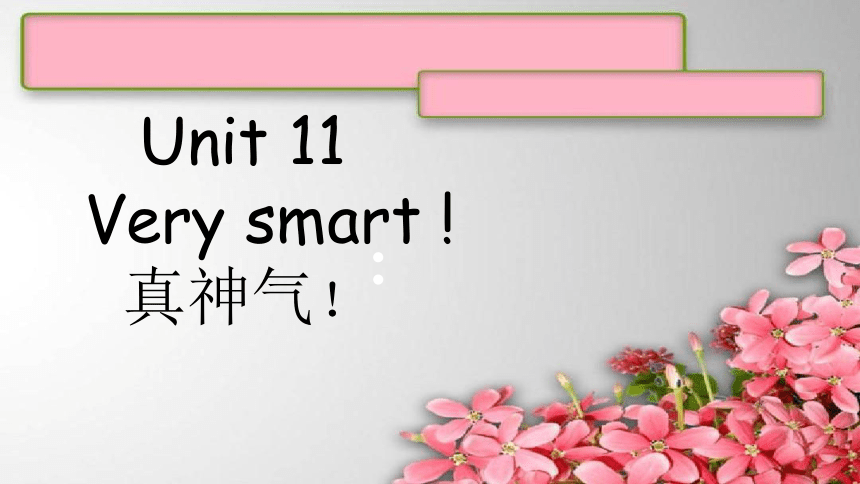
|
|
| 格式 | pptx | ||
| 文件大小 | 1.4MB | ||
| 资源类型 | 教案 | ||
| 版本资源 | 新概念英语 | ||
| 科目 | 英语 | ||
| 更新时间 | 2024-03-08 14:11:44 | ||
图片预览

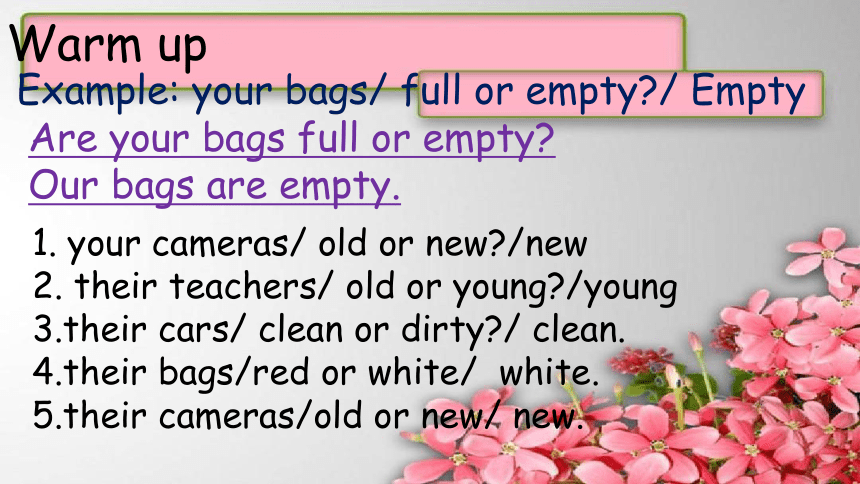
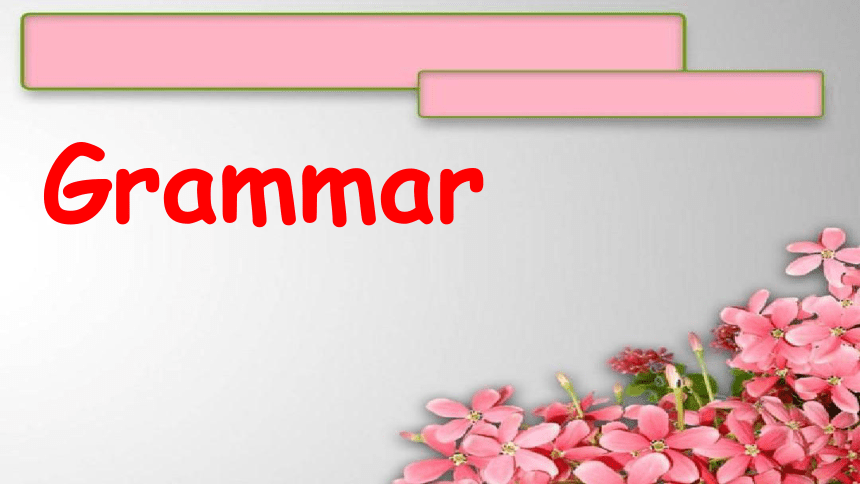
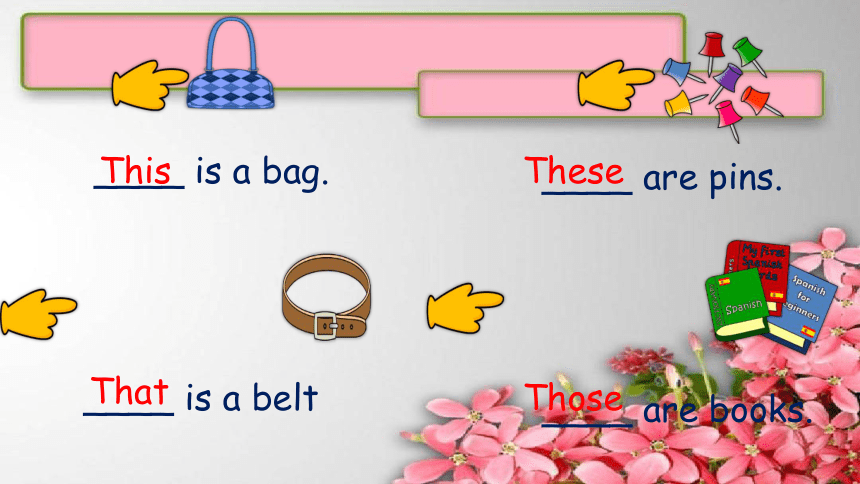
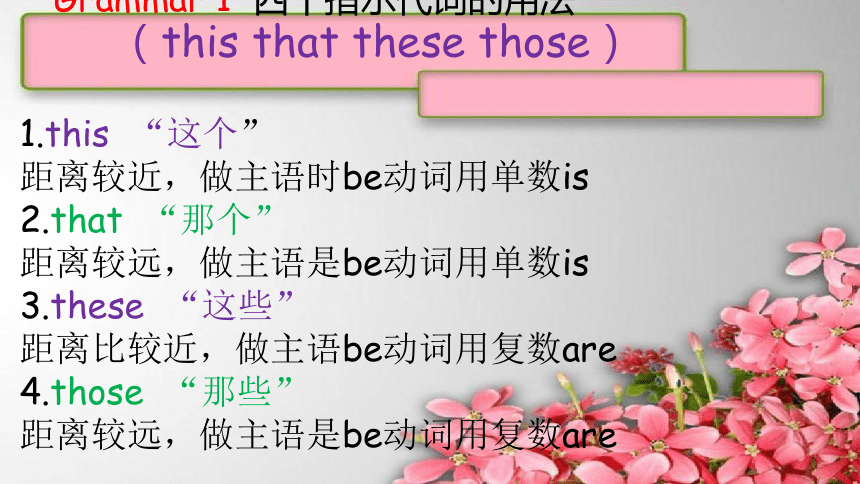
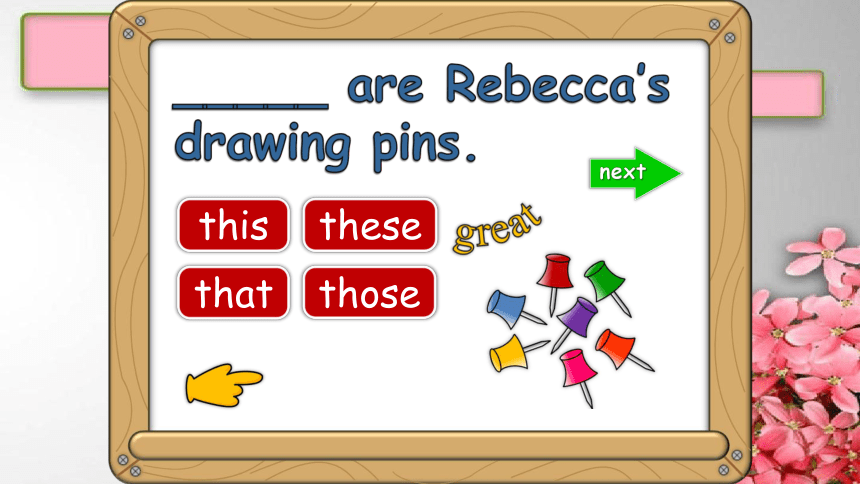
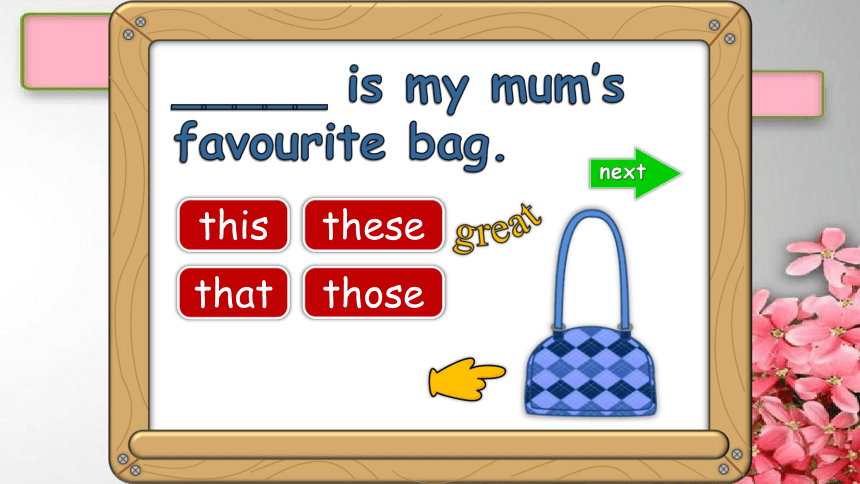
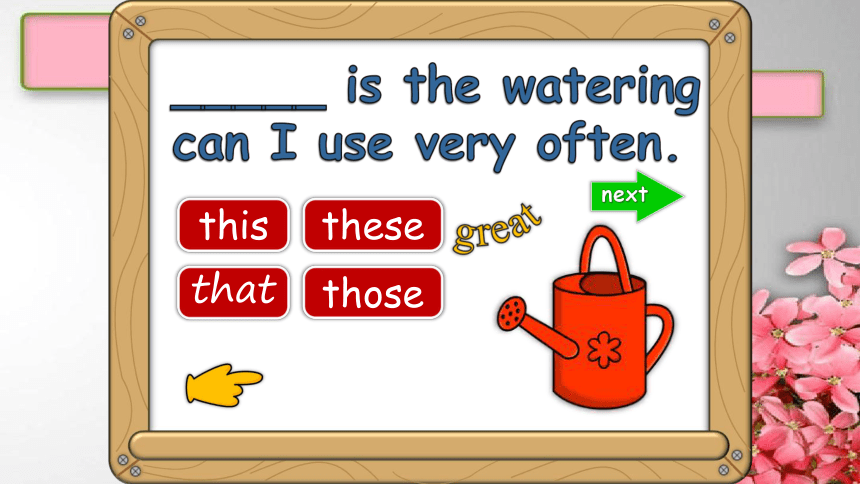
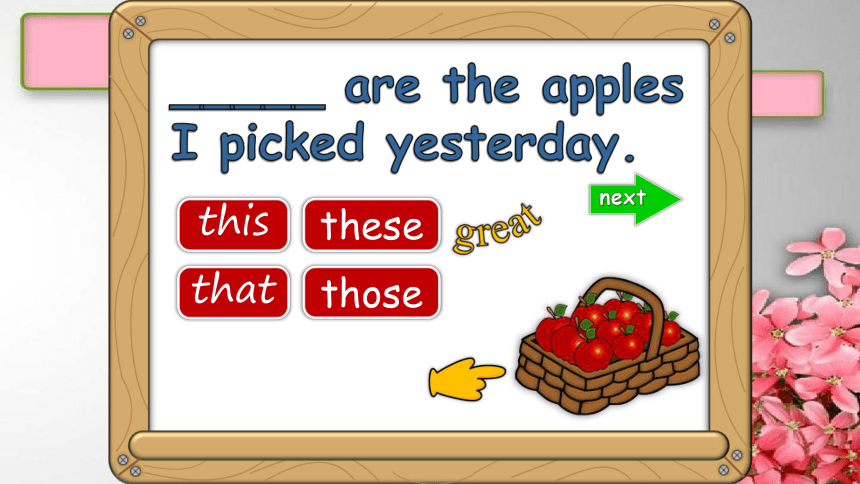
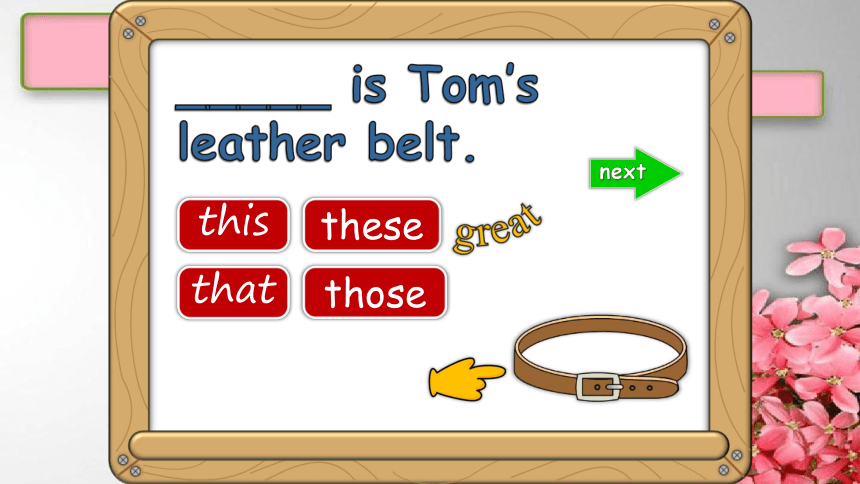
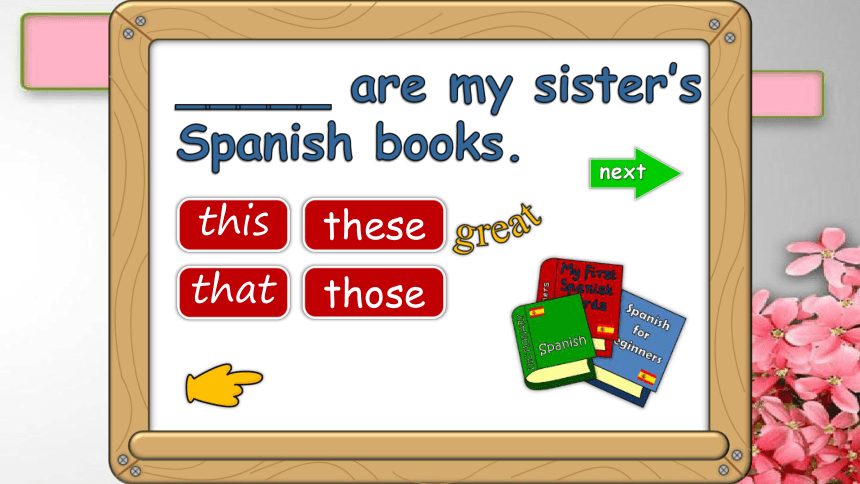
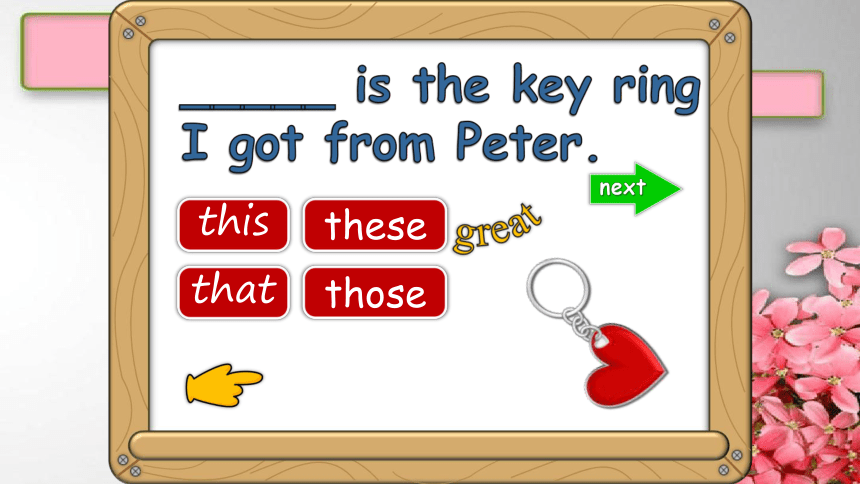
文档简介
(共38张PPT)
Unit 11
Very smart !
真神气!
Warm up
Example: your bags/ full or empty / Empty
Are your bags full or empty
Our bags are empty.
1. your cameras/ old or new /new
2. their teachers/ old or young /young
3.their cars/ clean or dirty / clean.
4.their bags/red or white/ white.
5.their cameras/old or new/ new.
Grammar
____ is a bag.
This
____ are pins.
These
____ is a belt
That
____ are books.
Those
Grammar 1 四个指示代词的用法
(this that these those)
1.this “这个”
距离较近,做主语时be动词用单数is
2.that “那个”
距离较远,做主语是be动词用单数is
3.these “这些”
距离比较近,做主语be动词用复数are
4.those “那些”
距离较远,做主语是be动词用复数are
_____ are Rebecca’s
drawing pins.
this
that
these
those
next
great
_____ is my mum’s
favourite bag.
this
that
these
those
next
great
_____ is the watering
can I use very often.
this
that
these
those
next
great
_____ are the apples
I picked yesterday.
this
that
these
those
next
great
_____ is Tom’s
leather belt.
this
that
these
those
next
great
_____ are my sister’s
Spanish books.
this
that
these
those
next
great
_____ is the key ring
I got from Peter.
this
that
these
those
next
great
_____ is my cousin’s
scooter.
this
that
these
those
next
great
_____ are my old
building blocks.
this
that
these
those
The end
great
2.名词所有格: 表示某物的所属关系。‘....的’
(1).通常直接在名称后面加's。
e.g: This is my mother’s skirt.
That is William's car.
(2).当遇到词尾以s结尾的复数名词或人名时,直接在名词后加撇(’)。
e.g. This is the girls' room.
That is the teachers’ office.
1.Tom and Jerry’s room.
(Tom和Jerry共同的房间)
2.Tom’s and Jerry’s room.
(Tom的房间和Jerry的房间)
3. Lucy and karen’s toy.
(Lucy和Karen共同的玩具)
4. Lucy’s and Karen’s toy.
(Lucy的玩具和Karen的玩具)
两者共有 A and B’s
eg:Tom and Jerry’s room
(Tom和Jerry共有的房间)
两者各自拥有 A’s and B’s
eg:Tom’s and Jerry’s room.
(Tom和Jerry各自的房间)
名词所有格
1.定义:名词的所有格表示所属关系。
构成方法:
(1)一般情况在名词后加’s
(2)以s结尾的复数名词或人名时,直接在名词后加撇(’)
(3)两者共有 A and B’s
eg:Tom and Jerry’s room(Tom和Jerry共有的房间)
(4)两者各自拥有 A’s and B’s
(Tom和Jerry各自的房间)
Do exercise
1.Lucy的钢笔 ____________ 2.Tom的书包 ____________
3.爸爸妈妈的车 __________ 4.Jack的和Jason的卧室 _________
5.Lucy和LiLi的球 ___________
Do exercise
6.Lili的连衣裙 __________
7.Karen和Robert的花 _________ 8.Jerry的照相机 ____________
9.Jenkins的书 ____________
10.Jack的和Jerry的椅子____________
New words
smart [smɑ t]
adj. 神气的
outfit [ a tf t]
n. 服装
interesting [ ntr st ]
adj. 有趣的
tie [ta ]
n. 领带,领结
elegant ['el g nt]
adj. 优雅的
unusual [ n'ju: u l]
adj. 独特的
New words and expressions
smart v.神气的
these 这些
outfit n.服装
play n.戏剧,演出
both (两者) 都
elegant adj. 优雅的
interesting adj. 有趣的
tie n.领带,领结
um 呃......
colourful adj.颜色鲜艳的
unusual adj.独特的
shoe n. 鞋
all right adj.合适的
part n. 角色
Passage
Robert: Look! These are our outfits for the school play.
Karen: Oh, very smart! Look, William!
William: Yes, you're both very elegant.
Lucy and Robert: Thank you, Dad.
William: That's an interesting tie, Robert.
Robert: Um, yes, thanks, Dad.
William: It's very colourful. Very unusual.
Robert: Yes, um, it's my favourite tie.
both 两者都
1.常放于be动词之后。
eg:Ther are both students.
2.both ...and... “........与.......两个都“
eg:She is both pretty and clever.
Karen: Those are funny shoes, Robert:Are they a bit big for you
Robert:These shoes No, Mum.
They're all right.
They're right for the part.
a bit 一点儿
用来修饰动词、副词、形容词。
Paul:Where are my new shoes
They aren't in my bedroom.
Karen and William: Oh, Robert!
Paul: Hey, Robert! That's my tie!
Those are my new shoes!
And those are my socks, too!
/eI/ wait late name play
Hey table they favourite
eight eighteen
感谢观看
THANK YOU
Unit 11
Very smart !
真神气!
Warm up
Example: your bags/ full or empty / Empty
Are your bags full or empty
Our bags are empty.
1. your cameras/ old or new /new
2. their teachers/ old or young /young
3.their cars/ clean or dirty / clean.
4.their bags/red or white/ white.
5.their cameras/old or new/ new.
Grammar
____ is a bag.
This
____ are pins.
These
____ is a belt
That
____ are books.
Those
Grammar 1 四个指示代词的用法
(this that these those)
1.this “这个”
距离较近,做主语时be动词用单数is
2.that “那个”
距离较远,做主语是be动词用单数is
3.these “这些”
距离比较近,做主语be动词用复数are
4.those “那些”
距离较远,做主语是be动词用复数are
_____ are Rebecca’s
drawing pins.
this
that
these
those
next
great
_____ is my mum’s
favourite bag.
this
that
these
those
next
great
_____ is the watering
can I use very often.
this
that
these
those
next
great
_____ are the apples
I picked yesterday.
this
that
these
those
next
great
_____ is Tom’s
leather belt.
this
that
these
those
next
great
_____ are my sister’s
Spanish books.
this
that
these
those
next
great
_____ is the key ring
I got from Peter.
this
that
these
those
next
great
_____ is my cousin’s
scooter.
this
that
these
those
next
great
_____ are my old
building blocks.
this
that
these
those
The end
great
2.名词所有格: 表示某物的所属关系。‘....的’
(1).通常直接在名称后面加's。
e.g: This is my mother’s skirt.
That is William's car.
(2).当遇到词尾以s结尾的复数名词或人名时,直接在名词后加撇(’)。
e.g. This is the girls' room.
That is the teachers’ office.
1.Tom and Jerry’s room.
(Tom和Jerry共同的房间)
2.Tom’s and Jerry’s room.
(Tom的房间和Jerry的房间)
3. Lucy and karen’s toy.
(Lucy和Karen共同的玩具)
4. Lucy’s and Karen’s toy.
(Lucy的玩具和Karen的玩具)
两者共有 A and B’s
eg:Tom and Jerry’s room
(Tom和Jerry共有的房间)
两者各自拥有 A’s and B’s
eg:Tom’s and Jerry’s room.
(Tom和Jerry各自的房间)
名词所有格
1.定义:名词的所有格表示所属关系。
构成方法:
(1)一般情况在名词后加’s
(2)以s结尾的复数名词或人名时,直接在名词后加撇(’)
(3)两者共有 A and B’s
eg:Tom and Jerry’s room(Tom和Jerry共有的房间)
(4)两者各自拥有 A’s and B’s
(Tom和Jerry各自的房间)
Do exercise
1.Lucy的钢笔 ____________ 2.Tom的书包 ____________
3.爸爸妈妈的车 __________ 4.Jack的和Jason的卧室 _________
5.Lucy和LiLi的球 ___________
Do exercise
6.Lili的连衣裙 __________
7.Karen和Robert的花 _________ 8.Jerry的照相机 ____________
9.Jenkins的书 ____________
10.Jack的和Jerry的椅子____________
New words
smart [smɑ t]
adj. 神气的
outfit [ a tf t]
n. 服装
interesting [ ntr st ]
adj. 有趣的
tie [ta ]
n. 领带,领结
elegant ['el g nt]
adj. 优雅的
unusual [ n'ju: u l]
adj. 独特的
New words and expressions
smart v.神气的
these 这些
outfit n.服装
play n.戏剧,演出
both (两者) 都
elegant adj. 优雅的
interesting adj. 有趣的
tie n.领带,领结
um 呃......
colourful adj.颜色鲜艳的
unusual adj.独特的
shoe n. 鞋
all right adj.合适的
part n. 角色
Passage
Robert: Look! These are our outfits for the school play.
Karen: Oh, very smart! Look, William!
William: Yes, you're both very elegant.
Lucy and Robert: Thank you, Dad.
William: That's an interesting tie, Robert.
Robert: Um, yes, thanks, Dad.
William: It's very colourful. Very unusual.
Robert: Yes, um, it's my favourite tie.
both 两者都
1.常放于be动词之后。
eg:Ther are both students.
2.both ...and... “........与.......两个都“
eg:She is both pretty and clever.
Karen: Those are funny shoes, Robert:Are they a bit big for you
Robert:These shoes No, Mum.
They're all right.
They're right for the part.
a bit 一点儿
用来修饰动词、副词、形容词。
Paul:Where are my new shoes
They aren't in my bedroom.
Karen and William: Oh, Robert!
Paul: Hey, Robert! That's my tie!
Those are my new shoes!
And those are my socks, too!
/eI/ wait late name play
Hey table they favourite
eight eighteen
感谢观看
THANK YOU
同课章节目录
- Unit 1 Meet the family!
- Unit 2 What is it?
- Unit 3 Who's that?
- Unit 4 Robert isn't well.
- Unit 5 Meet the neighbours!
- Unit 6 Gossip!
- Unit 7 Where's my pen?
- Unit 8 A bump in the nighe!
- Unit 9 Red,white and...pink!
- Unit 10 Jump in!
- Unit 11 Very smart!
- Unit 12 Just like you!
- Unit 13 Late or early
- Unit 14 One,two,three,catch!
- Unit 15 That's not fair!
